A Comparative Analysis of Global Fixed Interests and Share Investment
VerifiedAdded on 2020/03/28
|10
|2825
|68
Report
AI Summary
This report provides a comprehensive analysis of global fixed interests and share investment opportunities, focusing on the financial markets of Canada, the United States of America, the United Kingdom, and Australia. The study examines the influence of economic environments, interest rates, and the role of the internet in the financial sector. It delves into specific aspects of each country's market, including government bonds in Canada, shareholder activism in the United States, and the United Kingdom's position as a financial hub. The report compares the resilience of banks in these countries, particularly contrasting those in Australia with those in Canada. It highlights the impact of global financial crises and recommends key players for a global market portfolio. The analysis underscores the importance of understanding market dynamics, international investment strategies, and the significance of a country's financial strength on a global scale, including the influence of social and environmental considerations in the United Kingdom and the United States.
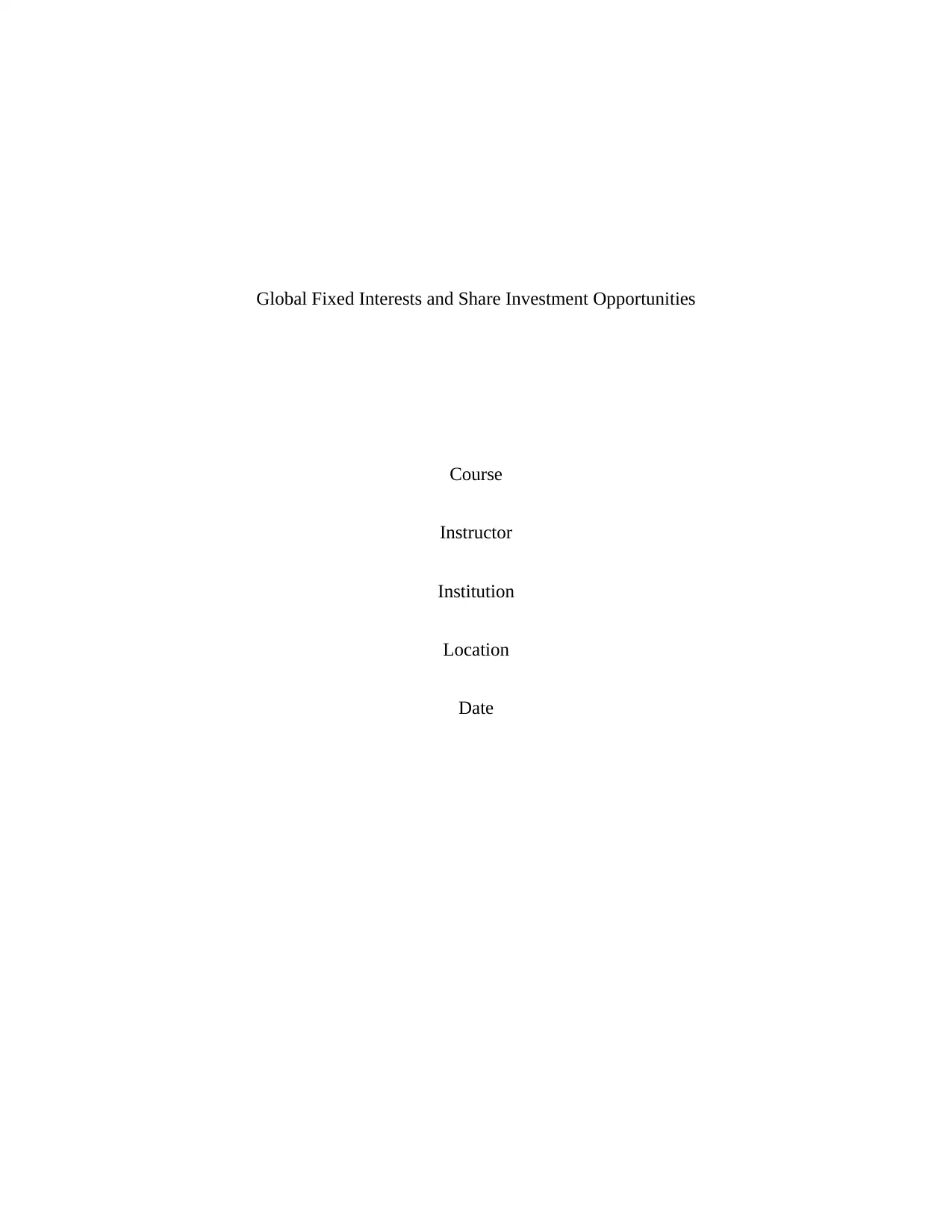
Global Fixed Interests and Share Investment Opportunities
Course
Instructor
Institution
Location
Date
Course
Instructor
Institution
Location
Date
Paraphrase This Document
Need a fresh take? Get an instant paraphrase of this document with our AI Paraphraser
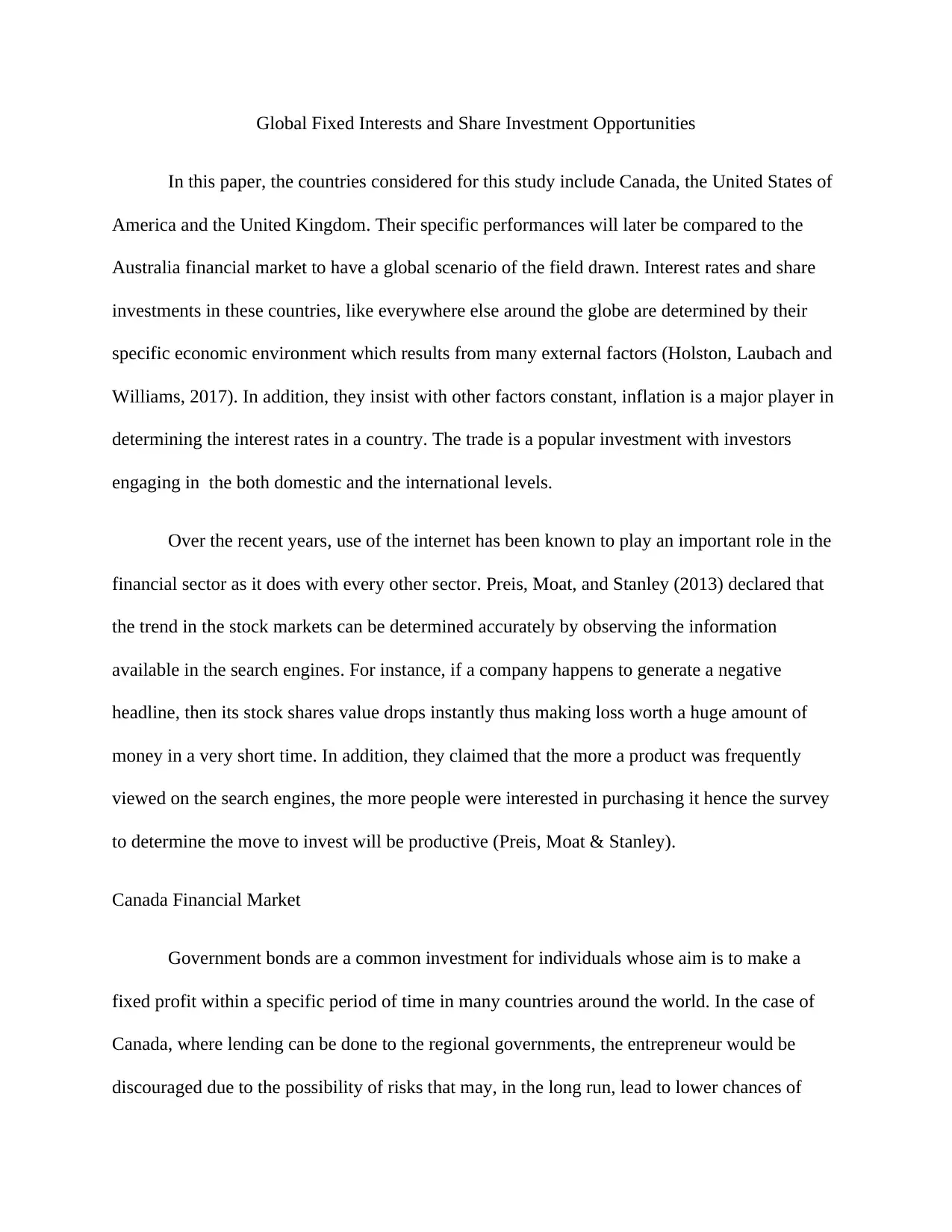
Global Fixed Interests and Share Investment Opportunities
In this paper, the countries considered for this study include Canada, the United States of
America and the United Kingdom. Their specific performances will later be compared to the
Australia financial market to have a global scenario of the field drawn. Interest rates and share
investments in these countries, like everywhere else around the globe are determined by their
specific economic environment which results from many external factors (Holston, Laubach and
Williams, 2017). In addition, they insist with other factors constant, inflation is a major player in
determining the interest rates in a country. The trade is a popular investment with investors
engaging in the both domestic and the international levels.
Over the recent years, use of the internet has been known to play an important role in the
financial sector as it does with every other sector. Preis, Moat, and Stanley (2013) declared that
the trend in the stock markets can be determined accurately by observing the information
available in the search engines. For instance, if a company happens to generate a negative
headline, then its stock shares value drops instantly thus making loss worth a huge amount of
money in a very short time. In addition, they claimed that the more a product was frequently
viewed on the search engines, the more people were interested in purchasing it hence the survey
to determine the move to invest will be productive (Preis, Moat & Stanley).
Canada Financial Market
Government bonds are a common investment for individuals whose aim is to make a
fixed profit within a specific period of time in many countries around the world. In the case of
Canada, where lending can be done to the regional governments, the entrepreneur would be
discouraged due to the possibility of risks that may, in the long run, lead to lower chances of
In this paper, the countries considered for this study include Canada, the United States of
America and the United Kingdom. Their specific performances will later be compared to the
Australia financial market to have a global scenario of the field drawn. Interest rates and share
investments in these countries, like everywhere else around the globe are determined by their
specific economic environment which results from many external factors (Holston, Laubach and
Williams, 2017). In addition, they insist with other factors constant, inflation is a major player in
determining the interest rates in a country. The trade is a popular investment with investors
engaging in the both domestic and the international levels.
Over the recent years, use of the internet has been known to play an important role in the
financial sector as it does with every other sector. Preis, Moat, and Stanley (2013) declared that
the trend in the stock markets can be determined accurately by observing the information
available in the search engines. For instance, if a company happens to generate a negative
headline, then its stock shares value drops instantly thus making loss worth a huge amount of
money in a very short time. In addition, they claimed that the more a product was frequently
viewed on the search engines, the more people were interested in purchasing it hence the survey
to determine the move to invest will be productive (Preis, Moat & Stanley).
Canada Financial Market
Government bonds are a common investment for individuals whose aim is to make a
fixed profit within a specific period of time in many countries around the world. In the case of
Canada, where lending can be done to the regional governments, the entrepreneur would be
discouraged due to the possibility of risks that may, in the long run, lead to lower chances of
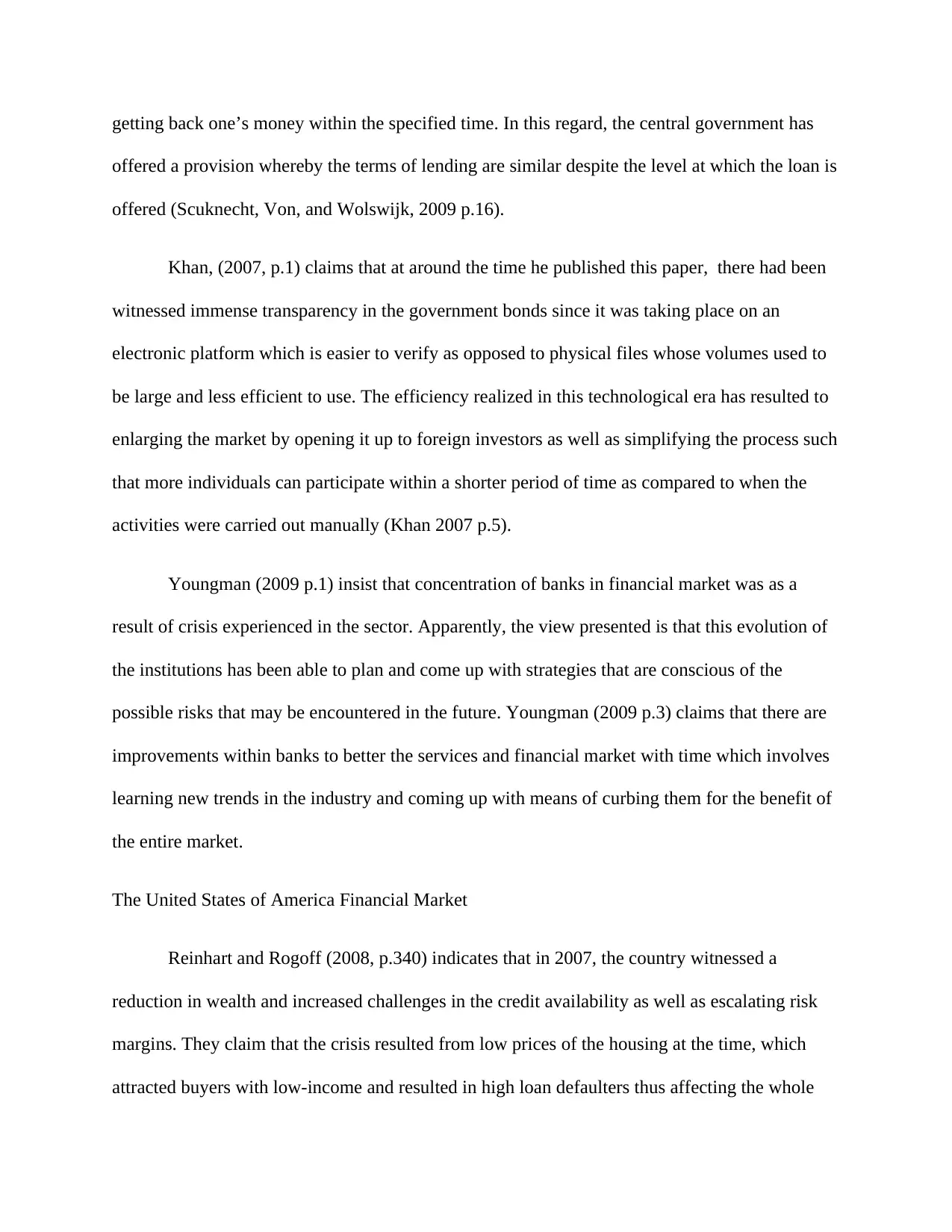
getting back one’s money within the specified time. In this regard, the central government has
offered a provision whereby the terms of lending are similar despite the level at which the loan is
offered (Scuknecht, Von, and Wolswijk, 2009 p.16).
Khan, (2007, p.1) claims that at around the time he published this paper, there had been
witnessed immense transparency in the government bonds since it was taking place on an
electronic platform which is easier to verify as opposed to physical files whose volumes used to
be large and less efficient to use. The efficiency realized in this technological era has resulted to
enlarging the market by opening it up to foreign investors as well as simplifying the process such
that more individuals can participate within a shorter period of time as compared to when the
activities were carried out manually (Khan 2007 p.5).
Youngman (2009 p.1) insist that concentration of banks in financial market was as a
result of crisis experienced in the sector. Apparently, the view presented is that this evolution of
the institutions has been able to plan and come up with strategies that are conscious of the
possible risks that may be encountered in the future. Youngman (2009 p.3) claims that there are
improvements within banks to better the services and financial market with time which involves
learning new trends in the industry and coming up with means of curbing them for the benefit of
the entire market.
The United States of America Financial Market
Reinhart and Rogoff (2008, p.340) indicates that in 2007, the country witnessed a
reduction in wealth and increased challenges in the credit availability as well as escalating risk
margins. They claim that the crisis resulted from low prices of the housing at the time, which
attracted buyers with low-income and resulted in high loan defaulters thus affecting the whole
offered a provision whereby the terms of lending are similar despite the level at which the loan is
offered (Scuknecht, Von, and Wolswijk, 2009 p.16).
Khan, (2007, p.1) claims that at around the time he published this paper, there had been
witnessed immense transparency in the government bonds since it was taking place on an
electronic platform which is easier to verify as opposed to physical files whose volumes used to
be large and less efficient to use. The efficiency realized in this technological era has resulted to
enlarging the market by opening it up to foreign investors as well as simplifying the process such
that more individuals can participate within a shorter period of time as compared to when the
activities were carried out manually (Khan 2007 p.5).
Youngman (2009 p.1) insist that concentration of banks in financial market was as a
result of crisis experienced in the sector. Apparently, the view presented is that this evolution of
the institutions has been able to plan and come up with strategies that are conscious of the
possible risks that may be encountered in the future. Youngman (2009 p.3) claims that there are
improvements within banks to better the services and financial market with time which involves
learning new trends in the industry and coming up with means of curbing them for the benefit of
the entire market.
The United States of America Financial Market
Reinhart and Rogoff (2008, p.340) indicates that in 2007, the country witnessed a
reduction in wealth and increased challenges in the credit availability as well as escalating risk
margins. They claim that the crisis resulted from low prices of the housing at the time, which
attracted buyers with low-income and resulted in high loan defaulters thus affecting the whole
⊘ This is a preview!⊘
Do you want full access?
Subscribe today to unlock all pages.

Trusted by 1+ million students worldwide
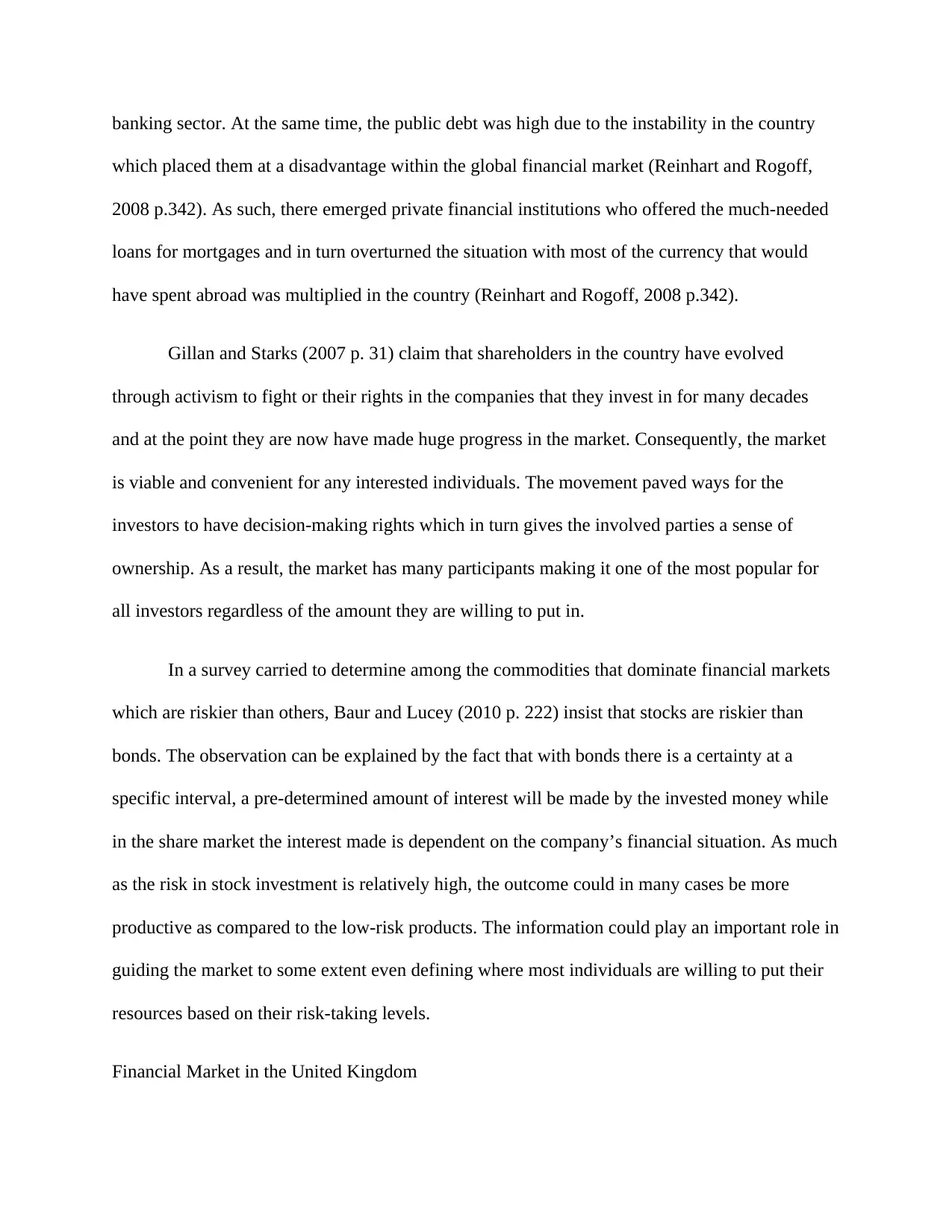
banking sector. At the same time, the public debt was high due to the instability in the country
which placed them at a disadvantage within the global financial market (Reinhart and Rogoff,
2008 p.342). As such, there emerged private financial institutions who offered the much-needed
loans for mortgages and in turn overturned the situation with most of the currency that would
have spent abroad was multiplied in the country (Reinhart and Rogoff, 2008 p.342).
Gillan and Starks (2007 p. 31) claim that shareholders in the country have evolved
through activism to fight or their rights in the companies that they invest in for many decades
and at the point they are now have made huge progress in the market. Consequently, the market
is viable and convenient for any interested individuals. The movement paved ways for the
investors to have decision-making rights which in turn gives the involved parties a sense of
ownership. As a result, the market has many participants making it one of the most popular for
all investors regardless of the amount they are willing to put in.
In a survey carried to determine among the commodities that dominate financial markets
which are riskier than others, Baur and Lucey (2010 p. 222) insist that stocks are riskier than
bonds. The observation can be explained by the fact that with bonds there is a certainty at a
specific interval, a pre-determined amount of interest will be made by the invested money while
in the share market the interest made is dependent on the company’s financial situation. As much
as the risk in stock investment is relatively high, the outcome could in many cases be more
productive as compared to the low-risk products. The information could play an important role in
guiding the market to some extent even defining where most individuals are willing to put their
resources based on their risk-taking levels.
Financial Market in the United Kingdom
which placed them at a disadvantage within the global financial market (Reinhart and Rogoff,
2008 p.342). As such, there emerged private financial institutions who offered the much-needed
loans for mortgages and in turn overturned the situation with most of the currency that would
have spent abroad was multiplied in the country (Reinhart and Rogoff, 2008 p.342).
Gillan and Starks (2007 p. 31) claim that shareholders in the country have evolved
through activism to fight or their rights in the companies that they invest in for many decades
and at the point they are now have made huge progress in the market. Consequently, the market
is viable and convenient for any interested individuals. The movement paved ways for the
investors to have decision-making rights which in turn gives the involved parties a sense of
ownership. As a result, the market has many participants making it one of the most popular for
all investors regardless of the amount they are willing to put in.
In a survey carried to determine among the commodities that dominate financial markets
which are riskier than others, Baur and Lucey (2010 p. 222) insist that stocks are riskier than
bonds. The observation can be explained by the fact that with bonds there is a certainty at a
specific interval, a pre-determined amount of interest will be made by the invested money while
in the share market the interest made is dependent on the company’s financial situation. As much
as the risk in stock investment is relatively high, the outcome could in many cases be more
productive as compared to the low-risk products. The information could play an important role in
guiding the market to some extent even defining where most individuals are willing to put their
resources based on their risk-taking levels.
Financial Market in the United Kingdom
Paraphrase This Document
Need a fresh take? Get an instant paraphrase of this document with our AI Paraphraser

Grinblatt and Titman (2016, p22) refer to London as the ancient financial headquarter due
to the growth experienced in earlier centuries when most of other parts of the world were far
from catching up. They add that although other cities around the globe have developed in equal
measure with the United Kingdom, it is still ahead of the stock, foreign currency as well as bonds
internationally. The success of the market is credited to use technology to ease the process as
well as allowing entry of companies from other countries to bring in competition as they
dismantle monopolies in the field (Grinblatt and Titman, p22). In addition, fixed commissions
that defined the market were excluded and the market was freed to allow traders to occupy the
position they were most comfortable with or even multiple niches at the same time.
The United Kingdom is arguably the largest market for Muslim financial services
according to Hoepner, Rammal, and Rezec (2011, p2). Being able to capture a large part of the
population and creating a service that is specific to their need is essential in ensuring that the
investor has an unchallenged customer base. Sustainability of the market is based on ensuring
that the services remain satisfactory to the target group to ensure they are not lured by
competitors (Hoepner, Rammal and Rezec, 2011 p.3). For a company that targets this group,
they should comply with specific guidelines in which way banks that have dominated the field in
the United Kingdom have adhered to (Hoepner, Rammals and Rezec 2011, p5).
The country has opened their market to international investors have increased their
capital and subsequently minimized costs incurred (Kay 2012, p2). However, he insists that the
integrity of the sector is dependent on the practices carried out such that negative publicity or
association with investors with a negative image may ruin the good reputation made over the
years (Kay 2012 p2). Reputation in the field is everything in the business as it is a sector driven
to the growth experienced in earlier centuries when most of other parts of the world were far
from catching up. They add that although other cities around the globe have developed in equal
measure with the United Kingdom, it is still ahead of the stock, foreign currency as well as bonds
internationally. The success of the market is credited to use technology to ease the process as
well as allowing entry of companies from other countries to bring in competition as they
dismantle monopolies in the field (Grinblatt and Titman, p22). In addition, fixed commissions
that defined the market were excluded and the market was freed to allow traders to occupy the
position they were most comfortable with or even multiple niches at the same time.
The United Kingdom is arguably the largest market for Muslim financial services
according to Hoepner, Rammal, and Rezec (2011, p2). Being able to capture a large part of the
population and creating a service that is specific to their need is essential in ensuring that the
investor has an unchallenged customer base. Sustainability of the market is based on ensuring
that the services remain satisfactory to the target group to ensure they are not lured by
competitors (Hoepner, Rammal and Rezec, 2011 p.3). For a company that targets this group,
they should comply with specific guidelines in which way banks that have dominated the field in
the United Kingdom have adhered to (Hoepner, Rammals and Rezec 2011, p5).
The country has opened their market to international investors have increased their
capital and subsequently minimized costs incurred (Kay 2012, p2). However, he insists that the
integrity of the sector is dependent on the practices carried out such that negative publicity or
association with investors with a negative image may ruin the good reputation made over the
years (Kay 2012 p2). Reputation in the field is everything in the business as it is a sector driven
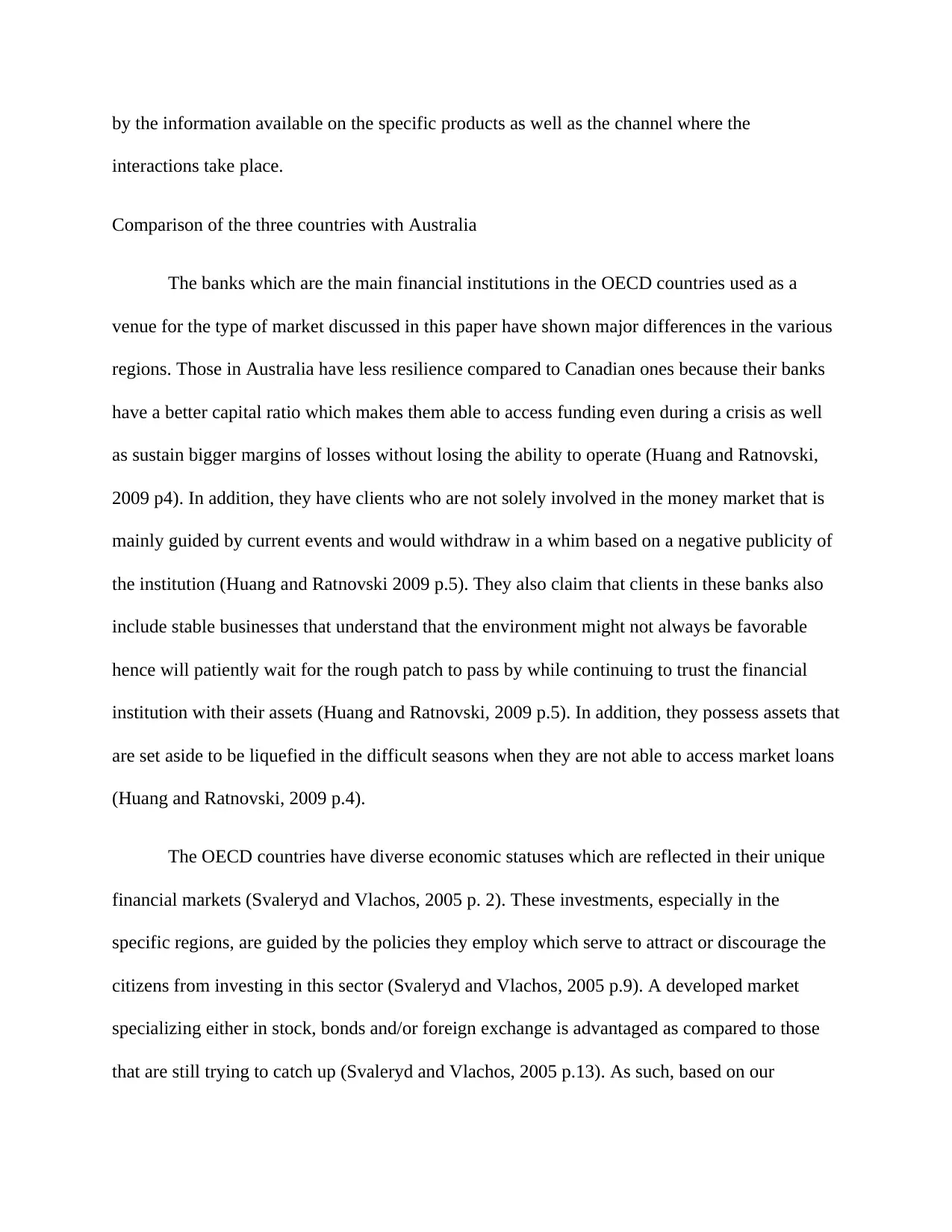
by the information available on the specific products as well as the channel where the
interactions take place.
Comparison of the three countries with Australia
The banks which are the main financial institutions in the OECD countries used as a
venue for the type of market discussed in this paper have shown major differences in the various
regions. Those in Australia have less resilience compared to Canadian ones because their banks
have a better capital ratio which makes them able to access funding even during a crisis as well
as sustain bigger margins of losses without losing the ability to operate (Huang and Ratnovski,
2009 p4). In addition, they have clients who are not solely involved in the money market that is
mainly guided by current events and would withdraw in a whim based on a negative publicity of
the institution (Huang and Ratnovski 2009 p.5). They also claim that clients in these banks also
include stable businesses that understand that the environment might not always be favorable
hence will patiently wait for the rough patch to pass by while continuing to trust the financial
institution with their assets (Huang and Ratnovski, 2009 p.5). In addition, they possess assets that
are set aside to be liquefied in the difficult seasons when they are not able to access market loans
(Huang and Ratnovski, 2009 p.4).
The OECD countries have diverse economic statuses which are reflected in their unique
financial markets (Svaleryd and Vlachos, 2005 p. 2). These investments, especially in the
specific regions, are guided by the policies they employ which serve to attract or discourage the
citizens from investing in this sector (Svaleryd and Vlachos, 2005 p.9). A developed market
specializing either in stock, bonds and/or foreign exchange is advantaged as compared to those
that are still trying to catch up (Svaleryd and Vlachos, 2005 p.13). As such, based on our
interactions take place.
Comparison of the three countries with Australia
The banks which are the main financial institutions in the OECD countries used as a
venue for the type of market discussed in this paper have shown major differences in the various
regions. Those in Australia have less resilience compared to Canadian ones because their banks
have a better capital ratio which makes them able to access funding even during a crisis as well
as sustain bigger margins of losses without losing the ability to operate (Huang and Ratnovski,
2009 p4). In addition, they have clients who are not solely involved in the money market that is
mainly guided by current events and would withdraw in a whim based on a negative publicity of
the institution (Huang and Ratnovski 2009 p.5). They also claim that clients in these banks also
include stable businesses that understand that the environment might not always be favorable
hence will patiently wait for the rough patch to pass by while continuing to trust the financial
institution with their assets (Huang and Ratnovski, 2009 p.5). In addition, they possess assets that
are set aside to be liquefied in the difficult seasons when they are not able to access market loans
(Huang and Ratnovski, 2009 p.4).
The OECD countries have diverse economic statuses which are reflected in their unique
financial markets (Svaleryd and Vlachos, 2005 p. 2). These investments, especially in the
specific regions, are guided by the policies they employ which serve to attract or discourage the
citizens from investing in this sector (Svaleryd and Vlachos, 2005 p.9). A developed market
specializing either in stock, bonds and/or foreign exchange is advantaged as compared to those
that are still trying to catch up (Svaleryd and Vlachos, 2005 p.13). As such, based on our
⊘ This is a preview!⊘
Do you want full access?
Subscribe today to unlock all pages.

Trusted by 1+ million students worldwide
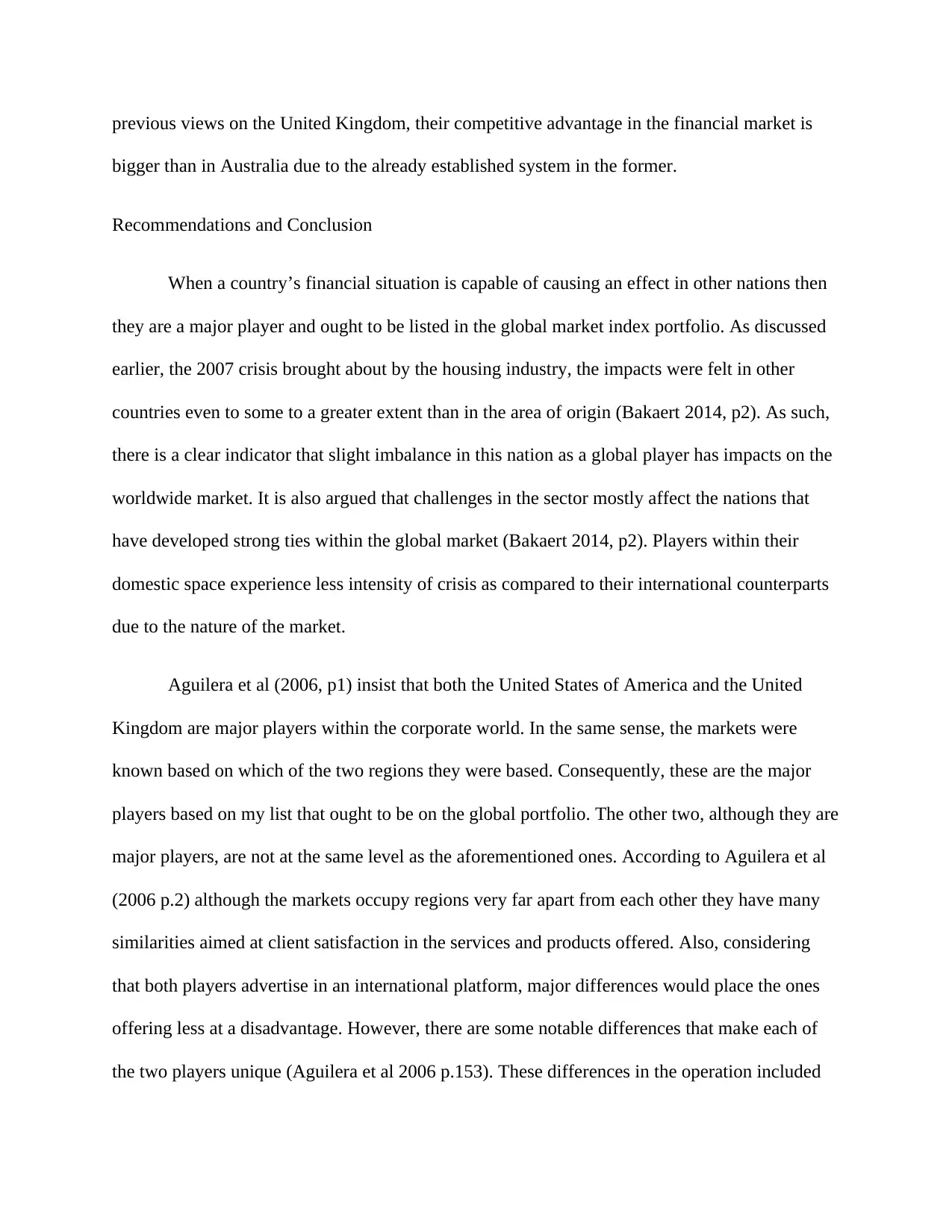
previous views on the United Kingdom, their competitive advantage in the financial market is
bigger than in Australia due to the already established system in the former.
Recommendations and Conclusion
When a country’s financial situation is capable of causing an effect in other nations then
they are a major player and ought to be listed in the global market index portfolio. As discussed
earlier, the 2007 crisis brought about by the housing industry, the impacts were felt in other
countries even to some to a greater extent than in the area of origin (Bakaert 2014, p2). As such,
there is a clear indicator that slight imbalance in this nation as a global player has impacts on the
worldwide market. It is also argued that challenges in the sector mostly affect the nations that
have developed strong ties within the global market (Bakaert 2014, p2). Players within their
domestic space experience less intensity of crisis as compared to their international counterparts
due to the nature of the market.
Aguilera et al (2006, p1) insist that both the United States of America and the United
Kingdom are major players within the corporate world. In the same sense, the markets were
known based on which of the two regions they were based. Consequently, these are the major
players based on my list that ought to be on the global portfolio. The other two, although they are
major players, are not at the same level as the aforementioned ones. According to Aguilera et al
(2006 p.2) although the markets occupy regions very far apart from each other they have many
similarities aimed at client satisfaction in the services and products offered. Also, considering
that both players advertise in an international platform, major differences would place the ones
offering less at a disadvantage. However, there are some notable differences that make each of
the two players unique (Aguilera et al 2006 p.153). These differences in the operation included
bigger than in Australia due to the already established system in the former.
Recommendations and Conclusion
When a country’s financial situation is capable of causing an effect in other nations then
they are a major player and ought to be listed in the global market index portfolio. As discussed
earlier, the 2007 crisis brought about by the housing industry, the impacts were felt in other
countries even to some to a greater extent than in the area of origin (Bakaert 2014, p2). As such,
there is a clear indicator that slight imbalance in this nation as a global player has impacts on the
worldwide market. It is also argued that challenges in the sector mostly affect the nations that
have developed strong ties within the global market (Bakaert 2014, p2). Players within their
domestic space experience less intensity of crisis as compared to their international counterparts
due to the nature of the market.
Aguilera et al (2006, p1) insist that both the United States of America and the United
Kingdom are major players within the corporate world. In the same sense, the markets were
known based on which of the two regions they were based. Consequently, these are the major
players based on my list that ought to be on the global portfolio. The other two, although they are
major players, are not at the same level as the aforementioned ones. According to Aguilera et al
(2006 p.2) although the markets occupy regions very far apart from each other they have many
similarities aimed at client satisfaction in the services and products offered. Also, considering
that both players advertise in an international platform, major differences would place the ones
offering less at a disadvantage. However, there are some notable differences that make each of
the two players unique (Aguilera et al 2006 p.153). These differences in the operation included
Paraphrase This Document
Need a fresh take? Get an instant paraphrase of this document with our AI Paraphraser

social and environmental welfare put into consideration by the corporate players in the United
Kingdom due to the need for these players to create a good public perception (Aguilera 2006
p.152). In the United States of America, there was less attention as compared to the European
counterparts most likely because their environment did not put them under pressure to provide
these services (Aguilera 2006 p.153).
Edison and Warnock (2004 p.1) claim that when financial markets involved only in
domestic trade, they reduce their risk index since it is lower on the international scene due to
stability and sharing among many players. In the same footing, if Australia and Canada were
able to play at the same level with their counterparts and open their markets to compete at the
ultimate level their chances of being viable to get similar portfolio would be increased.
References
Aguilera, R.V., Williams, C.A., Conley, J.M. and Rupp, D.E., 2006. Corporate governance and
social responsibility: A comparative analysis of the UK and the US. Corporate Governance: An
International Review, 14(3), pp147-158.
Aitken, R., Chaudhry, M.Q., Boxall, A.B.A. and Hull, M., 2006. Manufacture and use of
nanomaterials: currentstatus in the UK and global trends. Occupational medicine, 56(5), pp.300-
306.
Baur, D. G. and Lucey, B. M., 2010. Is gold a hedge or a safe haven? An analysis of stocks,
bonds and gold. Financial Review 45, no. 2 (2010): 217-229.
Bekaert, G., Ehrmann, M., Fratzscher, M. and Mehl, A., 2014. The global crisis and equity
market contagion. The Journal of Finance, 69(6), pp.2597-2649.
Kingdom due to the need for these players to create a good public perception (Aguilera 2006
p.152). In the United States of America, there was less attention as compared to the European
counterparts most likely because their environment did not put them under pressure to provide
these services (Aguilera 2006 p.153).
Edison and Warnock (2004 p.1) claim that when financial markets involved only in
domestic trade, they reduce their risk index since it is lower on the international scene due to
stability and sharing among many players. In the same footing, if Australia and Canada were
able to play at the same level with their counterparts and open their markets to compete at the
ultimate level their chances of being viable to get similar portfolio would be increased.
References
Aguilera, R.V., Williams, C.A., Conley, J.M. and Rupp, D.E., 2006. Corporate governance and
social responsibility: A comparative analysis of the UK and the US. Corporate Governance: An
International Review, 14(3), pp147-158.
Aitken, R., Chaudhry, M.Q., Boxall, A.B.A. and Hull, M., 2006. Manufacture and use of
nanomaterials: currentstatus in the UK and global trends. Occupational medicine, 56(5), pp.300-
306.
Baur, D. G. and Lucey, B. M., 2010. Is gold a hedge or a safe haven? An analysis of stocks,
bonds and gold. Financial Review 45, no. 2 (2010): 217-229.
Bekaert, G., Ehrmann, M., Fratzscher, M. and Mehl, A., 2014. The global crisis and equity
market contagion. The Journal of Finance, 69(6), pp.2597-2649.
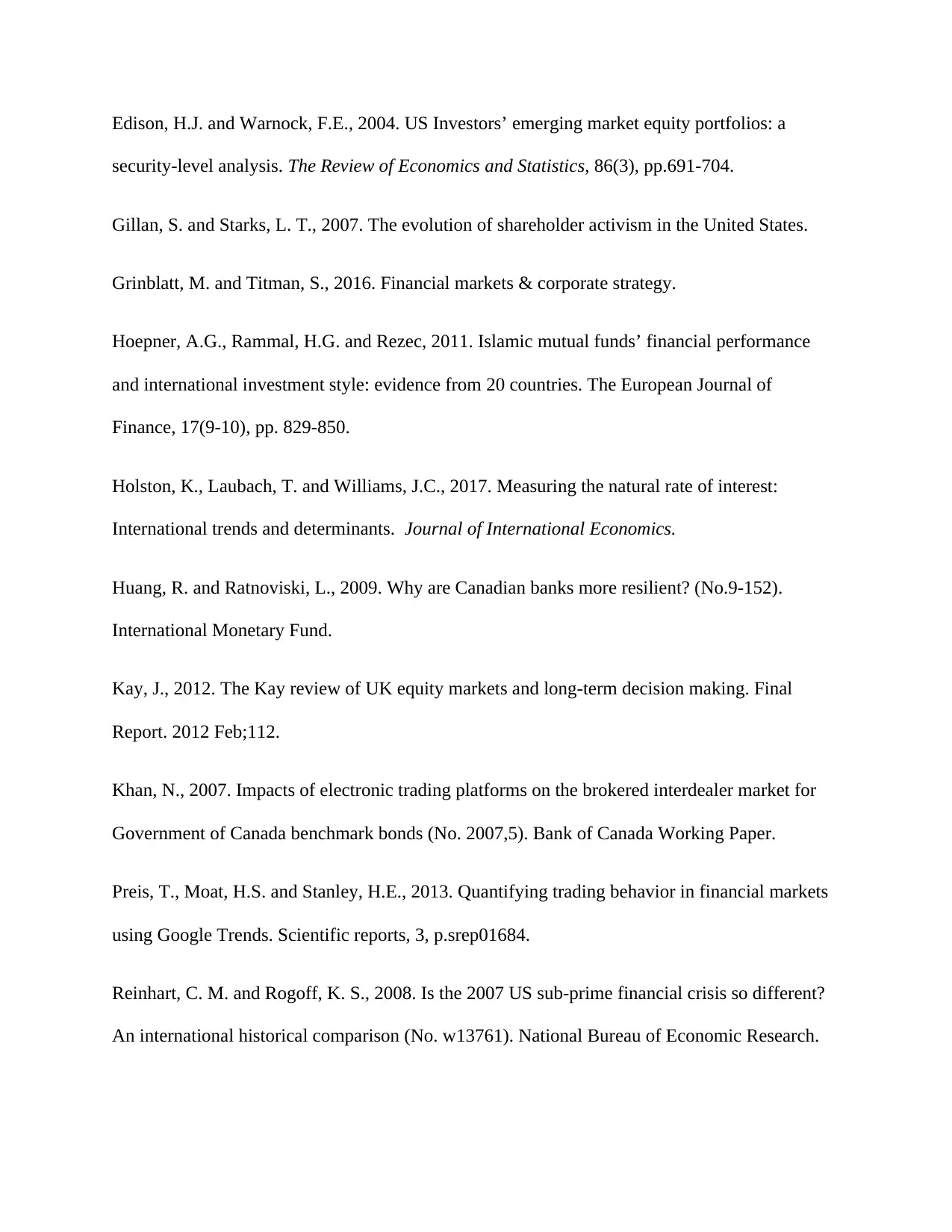
Edison, H.J. and Warnock, F.E., 2004. US Investors’ emerging market equity portfolios: a
security-level analysis. The Review of Economics and Statistics, 86(3), pp.691-704.
Gillan, S. and Starks, L. T., 2007. The evolution of shareholder activism in the United States.
Grinblatt, M. and Titman, S., 2016. Financial markets & corporate strategy.
Hoepner, A.G., Rammal, H.G. and Rezec, 2011. Islamic mutual funds’ financial performance
and international investment style: evidence from 20 countries. The European Journal of
Finance, 17(9-10), pp. 829-850.
Holston, K., Laubach, T. and Williams, J.C., 2017. Measuring the natural rate of interest:
International trends and determinants. Journal of International Economics.
Huang, R. and Ratnoviski, L., 2009. Why are Canadian banks more resilient? (No.9-152).
International Monetary Fund.
Kay, J., 2012. The Kay review of UK equity markets and long-term decision making. Final
Report. 2012 Feb;112.
Khan, N., 2007. Impacts of electronic trading platforms on the brokered interdealer market for
Government of Canada benchmark bonds (No. 2007,5). Bank of Canada Working Paper.
Preis, T., Moat, H.S. and Stanley, H.E., 2013. Quantifying trading behavior in financial markets
using Google Trends. Scientific reports, 3, p.srep01684.
Reinhart, C. M. and Rogoff, K. S., 2008. Is the 2007 US sub-prime financial crisis so different?
An international historical comparison (No. w13761). National Bureau of Economic Research.
security-level analysis. The Review of Economics and Statistics, 86(3), pp.691-704.
Gillan, S. and Starks, L. T., 2007. The evolution of shareholder activism in the United States.
Grinblatt, M. and Titman, S., 2016. Financial markets & corporate strategy.
Hoepner, A.G., Rammal, H.G. and Rezec, 2011. Islamic mutual funds’ financial performance
and international investment style: evidence from 20 countries. The European Journal of
Finance, 17(9-10), pp. 829-850.
Holston, K., Laubach, T. and Williams, J.C., 2017. Measuring the natural rate of interest:
International trends and determinants. Journal of International Economics.
Huang, R. and Ratnoviski, L., 2009. Why are Canadian banks more resilient? (No.9-152).
International Monetary Fund.
Kay, J., 2012. The Kay review of UK equity markets and long-term decision making. Final
Report. 2012 Feb;112.
Khan, N., 2007. Impacts of electronic trading platforms on the brokered interdealer market for
Government of Canada benchmark bonds (No. 2007,5). Bank of Canada Working Paper.
Preis, T., Moat, H.S. and Stanley, H.E., 2013. Quantifying trading behavior in financial markets
using Google Trends. Scientific reports, 3, p.srep01684.
Reinhart, C. M. and Rogoff, K. S., 2008. Is the 2007 US sub-prime financial crisis so different?
An international historical comparison (No. w13761). National Bureau of Economic Research.
⊘ This is a preview!⊘
Do you want full access?
Subscribe today to unlock all pages.

Trusted by 1+ million students worldwide
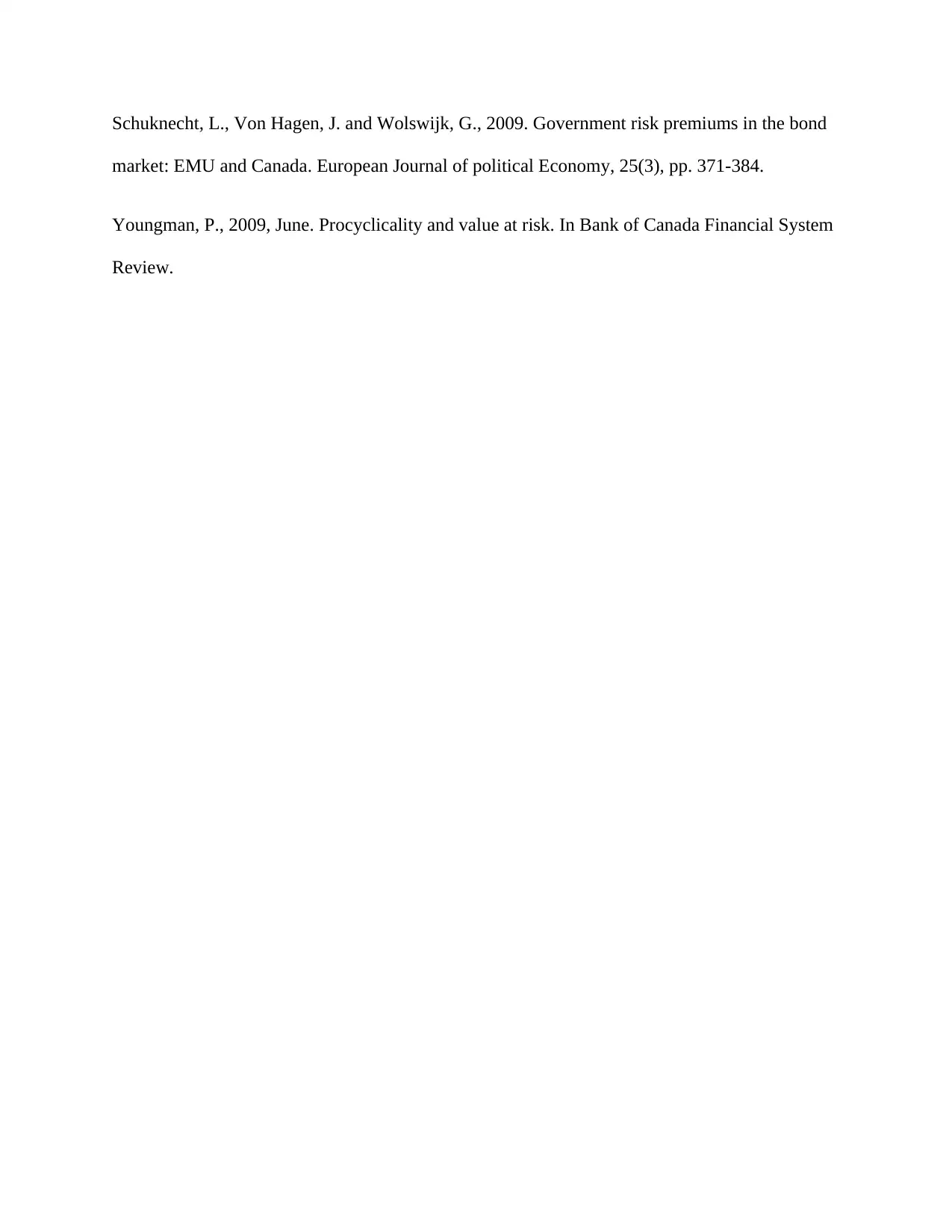
Schuknecht, L., Von Hagen, J. and Wolswijk, G., 2009. Government risk premiums in the bond
market: EMU and Canada. European Journal of political Economy, 25(3), pp. 371-384.
Youngman, P., 2009, June. Procyclicality and value at risk. In Bank of Canada Financial System
Review.
market: EMU and Canada. European Journal of political Economy, 25(3), pp. 371-384.
Youngman, P., 2009, June. Procyclicality and value at risk. In Bank of Canada Financial System
Review.
1 out of 10
Related Documents
Your All-in-One AI-Powered Toolkit for Academic Success.
+13062052269
info@desklib.com
Available 24*7 on WhatsApp / Email
![[object Object]](/_next/static/media/star-bottom.7253800d.svg)
Unlock your academic potential
Copyright © 2020–2026 A2Z Services. All Rights Reserved. Developed and managed by ZUCOL.




